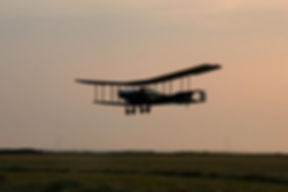
DH-4 m2 Mailplane
I first came across this aeroplane as a photo in a magazine and immediately felt the WOW! factor.
An American built DH-4 powered by a 400hp Liberty engine.
The m denotes a metal tube fuselage as opposed to the previous wooden ones and the 2 denote the later builds with thicker metal tube fuselage.
This DH-4 was restored by Peck Aeroplane Restoration and is housed at the Historic Aircraft Restoration Museum. in the USA.
I did some on-line research and found plenty of info, photos and videos of the DH4.
So I built this example for competition flying in the UK.



I started with the tail surfaces to give me a chance to get into the right frame of mind.
Standard sandwich construction with a 1/32nd balsa core to which is added 1/8th balsa strips for the ribs. The outlines are 1mm ali tube to achieve a sharp thin edge.

Wings were next. I designed the main rib with paper and pencil and a friend converted the drawing onto 2D CAD. The file was sent to a company to have the ribs laser cut. Ribs were then adjusted as required during the build.
Main spars are spruce. Leading and trailing edges carbon fibre tube.
Wing tips are edged with 1.5mm ali tube to form a good shape and be durable in use.

Rear decking is 1/16th squ spruce. This wood was selected to prevent the covering pulling in the stringers and looking like a starved horse. Tail surface mounting fitted and checked for a square fit.
Pilot is a bit over enthused. It will not fly just yet.


The cabane is epoxied and taped into place. The cross-wires are thicker than scale to absorb the twisting and shearing that can be exerted in a rough landing


The real one for comparislon
The cockpit interior was fitted out at this stage so that there was plenty of access through the sides and underneath. Items are bits and bobs from the odds and sods box. The photo I used was good enough to copy for the instument faces.


The undercarriage is a bit of a cats cradle and a bit tricky to get the shock absorber bungee arrangement a reasonable likeness.
The axle will pass through the rectangular slots and be bound by hat elastic.


First job was to purchase a planishing hammer.
A former was made out of plywood and a jubilee clip fashioned to the same shape.
A strip of 1.5mm ali was cut and clamped in place having previously annealed it.
The ali was slowly worked around the former to make the front cowling. It was then trimmed to shape and the ends epoxied together.


Radiator louvres are made of 1/64th ply. Trimmed to fit the cowl and whole thing was fixed to fuselage front, making sure the engine crankshaft exits in the right place and angle. The engine needs 1.5 degrees of right thrust and 3 degrees of down so the engine mount is offset to keep the crankshaft centred.

A Mills 1.3 diesel engine is installed on an ali' engine plate and screwed to the bearers. Remote fuel tank is fitted as the integral Mills tank was found to be hidden too much by the fuselage sides and I would not be able to see the fuel level and therefore judge the length of engine run.

Wheel are laminated from ply and balsa, turned on a "lathe" and sanded to shape. Tyres are neoprene sponge rubber.


Engine top cowling, fuselage sheeting, top decking, struts, axle and wheels are fitted
A lot of head scratching went on to try and work out how to do the cowling louvres. In the end I opted for the simple solution and cut the louvres into lithoplate and eased opened with a scalpel blade and enlarged slowly with a screwdriver tip. Epoxy resin is "painted" on the inside to secure in place and strengthen them to prevent them being crushed in use.

All put together and ready for covering.

The tail surfaces and rear fuselage are double covered in light weight jap tissue. The grain of the tissue of the second layer is at right angles to the first layer. This gives a lot of strength and still very light.
The wings are double covered with silk over heavyweight jap tissue. Strength, durability and a very good fabric appearance can be achieved like this with a worthwhile small weight penalty.
Metal parts are given a primer coat to accept paint finish.


Fuselage is painted in matt Humbrol enamel. The silver is Spectrum gloss silver spray.

To achieve a good surface texture on the fuselage two coats of gloss fuel proofer was applied.

.jpg)
Just when one thinks you are getting towards the end of the build the scale detail needs adding. It is intended to compete with this model so the details are important to give the model as real an appearance as possible.
I had to wait nearly a year to test fly and trim the DH4 because of the covid pandemic restrictions.
The model only needed an extra 2 degrees of down thrust to achieve a safe flight.
